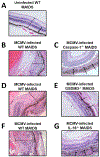Atypical cytomegalovirus retinal disease in pyroptosis-deficient mice with murine acquired immunodeficiency syndrome
- PMID: 34097907
- PMCID: PMC8595509
- DOI: 10.1016/j.exer.2021.108651
Atypical cytomegalovirus retinal disease in pyroptosis-deficient mice with murine acquired immunodeficiency syndrome
Abstract
Pyroptosis is a caspase-dependent programmed cell death pathway that initiates and sustains inflammation through release of pro-inflammatory cytokines interleukin (IL)-1β and IL-18 following formation of gasdermin D (GSDMD)-mediated membrane pores. To determine the possible pathogenic contributions of pyroptosis toward development of full-thickness retinal necrosis during AIDS-related human cytomegalovirus retinitis, we performed a series of studies using an established model of experimental murine cytomegalovirus (MCMV) retinitis in mice with retrovirus-induced immunosuppression (MAIDS). Initial investigations demonstrated significant transcription and translation of key pyroptosis-associated genes within the ocular compartments of MCMV-infected eyes of mice with MAIDS. Subsequent investigations compared MCMV-infected eyes of groups of wildtype MAIDS mice with MCMV-infected eyes of groups of caspase-1-/- MAIDS mice, GSDMD-/- MAIDS mice, or IL-18-/- MAIDS mice to explore a possible contribution of pyroptosis towards the pathogenesis of MAIDS-related MCMV retinitis. Histopathologic analysis revealed typical full-thickness retinal necrosis in 100% of MCMV-infected eyes of wildtype MAIDS mice. In sharp contrast, none (0%) of MCMV-infected eyes of MAIDS mice that were deficient in either caspase-1, GSDMD, or IL-18 developed full-thickness retinal necrosis but instead exhibited an atypical pattern of retinal disease characterized by thickening and proliferation of the retinal pigmented epithelium layer with relative sparing of the neurosensory retina. Surprisingly, MCMV-infected eyes of all groups of deficient MAIDS mice harbored equivalent intraocular amounts of infectious virus as seen in MCMV-infected eyes of groups of wildtype MAIDS mice despite failure to develop full-thickness retinal necrosis. We conclude that pyroptosis plays a significant role in the development of full-thickness retinal necrosis during the pathogenesis of MAIDS-related MCMV retinitis. This observation may extend to the pathogenesis of AIDS-related HCMV retinitis and other AIDS-related opportunistic virus infections.
Keywords: AIDS; Cell death pathway; Human cytomegalovirus; MAIDS; Murine cytomegalovirus; Pyroptosis; Retinitis.
Copyright © 2021 The Authors. Published by Elsevier Ltd.. All rights reserved.
Conflict of interest statement
Declaration of competing interest
The authors declare that they have no competing financial interests.
Figures




Similar articles
-
A Mouse Model That Mimics AIDS-Related Cytomegalovirus Retinitis: Insights into Pathogenesis.Pathogens. 2021 Jul 6;10(7):850. doi: 10.3390/pathogens10070850. Pathogens. 2021. PMID: 34358000 Free PMC article. Review.
-
Evidence for multiple cell death pathways during development of experimental cytomegalovirus retinitis in mice with retrovirus-induced immunosuppression: apoptosis, necroptosis, and pyroptosis.J Virol. 2012 Oct;86(20):10961-78. doi: 10.1128/JVI.01275-12. Epub 2012 Jul 25. J Virol. 2012. PMID: 22837196 Free PMC article.
-
Transcriptional analysis of immune response genes during pathogenesis of cytomegalovirus retinitis in mice with murine acquired immunodeficiency syndrome.PLoS Pathog. 2020 Nov 6;16(11):e1009032. doi: 10.1371/journal.ppat.1009032. eCollection 2020 Nov. PLoS Pathog. 2020. PMID: 33156834 Free PMC article.
-
Murine cytomegalovirus downregulates interleukin-17 in mice with retrovirus-induced immunosuppression that are susceptible to experimental cytomegalovirus retinitis.Cytokine. 2013 Mar;61(3):862-75. doi: 10.1016/j.cyto.2013.01.009. Epub 2013 Feb 14. Cytokine. 2013. PMID: 23415673 Free PMC article.
-
Interleukin-2 immunotherapy and AIDS-related cytomegalovirus retinitis.Curr HIV Res. 2004 Oct;2(4):333-42. doi: 10.2174/1570162043351066. Curr HIV Res. 2004. PMID: 15544454 Review.
Cited by
-
Spotlight on pyroptosis: role in pathogenesis and therapeutic potential of ocular diseases.J Neuroinflammation. 2022 Jul 14;19(1):183. doi: 10.1186/s12974-022-02547-2. J Neuroinflammation. 2022. PMID: 35836195 Free PMC article. Review.
-
Immune responses drive chorioretinitis and retinal pathology after neonatal CMV infection.Sci Adv. 2024 Nov 22;10(47):eadn6379. doi: 10.1126/sciadv.adn6379. Epub 2024 Nov 20. Sci Adv. 2024. PMID: 39565860 Free PMC article.
-
The Host-Pathogen Interplay: A Tale of Two Stories within the Cornea and Posterior Segment.Microorganisms. 2023 Aug 12;11(8):2074. doi: 10.3390/microorganisms11082074. Microorganisms. 2023. PMID: 37630634 Free PMC article. Review.
-
A Mouse Model That Mimics AIDS-Related Cytomegalovirus Retinitis: Insights into Pathogenesis.Pathogens. 2021 Jul 6;10(7):850. doi: 10.3390/pathogens10070850. Pathogens. 2021. PMID: 34358000 Free PMC article. Review.
-
PANoptosis in Viral Infection: The Missing Puzzle Piece in the Cell Death Field.J Mol Biol. 2022 Feb 28;434(4):167249. doi: 10.1016/j.jmb.2021.167249. Epub 2021 Sep 16. J Mol Biol. 2022. PMID: 34537233 Free PMC article. Review.
References
-
- Alston Carter JJ, Dix RD, I. C, 2017. Cytomegalovirus and the-Eye: AIDS-Related Retinitis and Beyond. Herpesviridae 42.
-
- Alston CI, Dix RD, 2017. Reduced frequency of murine cytomegalovirus retinitis in C57BL/6 mice correlates with low levels of suppressor of cytokine signaling (SOCS)1 and SOCS3 expression within the eye during corticosteroid-induced immunosuppression. Cytokine 97, 38–41. 10.1016/j.cyto.2017.05.021 - DOI - PMC - PubMed
-
- Atherton SS, Newell CK, Kanter MY, Cousins SW, 1991. Retinitis in euthymic mice following inoculation of murine cytomegalovirus (MCMV) via the supraciliary route. Curr Eye Res 10, 667–677. - PubMed
Publication types
MeSH terms
Grants and funding
LinkOut - more resources
Full Text Sources
Molecular Biology Databases
Miscellaneous

